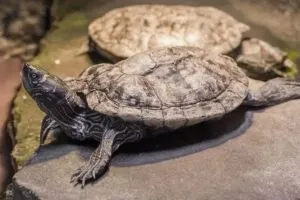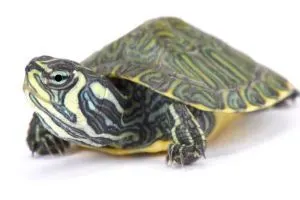Pond slider turtles are mid-sized aquatic turtles native to North America, specifically, they are commonly found in central North America. This species is popularly kept as pets. They are quite easy to care for and have bright colorations and patterns.
This makes sliders the perfect herptiles for beginners. There are three types of pond sliders and these are the red-eared slider, the Cumberland slider, and the yellow-bellied slider.
A hybrid between yellow-bellied and red-eared sliders is also common. Several other turtle species throughout the Americas are referred to as sliders. Interestingly enough, pond slider eggs have a distinct yellow marking, which helps in identifying them in the wild.
All of these species belong to the genus Trachemys. Our main focus here is pond sliders.
Table of Contents
- Experience Level: Beginner
- Family: Emydidae
- Scientific Name: Trachemys scripta
- Average Adult Size: 4 to 12 inches
- Lifespan: 20 to 50 years
- Clutch Size: 6 to 11 eggs
- Egg Incubation Period: 60 to 95 days
- Food: Aquatic turtle food, dark leafy vegetables, sliced vegetables, non-toxic aquatic plants, insects, and small fish
- Tank Size: 40 – 100 gallons (10 gallons per inch of turtle)
- Average Temperature: 90°H/75°L
- UVB Lighting: Needed
- Average Price Range: $25 to $50
- Conservation Status: Least concern
Types of Pond Slider Turtles
1. Red-eared Slider

- Experience Level: Beginner
- Family: Emydidae
- Scientific Name: Trachemys scripta elegans
- Common names: Slider turtle, red-eared turtle, red-eared terrapin, red-eared slider turtle, and water slider turtle
- Average Adult Size: 6 to 8 inches
- Lifespan: 20 to 40 years
- Average Price Range: $15 to $50
- Conservation Status: Least concern
Red-eared sliders are resilient, friendly, and fun to care for. These turtles can be easily identified by their distinct red visible markings, the red streaks on either side of their heads.
Because of their attractive nature, affordability, and availability, red-eared sliders are one of the most popular pets in the United States and possibly the world. Due to their popularity in the pet trade, red-eared sliders are widely available and are the most traded in the world.
The red-eared slider is native to the Mississippi River drainage and the areas around the Gulf of Mexico. It’s important to understand their native range to provide a suitable habitat. In addition to this, they can also be found from Colorado to Virginia, Northern Florida and as far West as Eastern New Mexico. As native species, they play a crucial role in their natural habitats.
In urban areas like New York, red-eared sliders are often spotted in local ponds and lakes.
While they are popular as pets, they are also among the most invasive species in the world and are capable of destroying entire ecosystems that they are not native to.
Because of this, their import has been banned in many countries across the world. Despite these restrictions, they are found in various parts of the world as pets, including regions in South America and Central America.
Fun fact, the Teenage Mutant Ninja Turtles are specimens of the red-eared slider.
2. Cumberland Slider

- Family: Emydidae
- Scientific Name: Trachemys scripta troostii
- Average Adult Female Size:8 to 10 inches
- Average Adult Male Size: 5 to 7 inches
- Lifespan: 40 to 50 years
- Average Price Range: $20 to $30
- Conservation Status: Least concern
The Cumberland slider is a subspecies of pond slider that is native to the Tennessee and Mississippi River drainage areas and the southeast of North America.
Like the Red and Yellow slider, it is also a very popular pet since it is relatively easy to care for.
The Cumberland Slider is distinguishable by a dark spot on its plastron.
3. Yellow-bellied Slider

- Family: Emydidae
- Scientific Name: Trachemys scripta scripta
- Average Adult Female Size:8 to 13 inches
- Average Adult Male Size: 5 to 9 inches
- Lifespan: 20 to 40 years
- Average Price Range: $15 to $50
- Conservation Status: Least concern
Just like red-eared sliders, yellow-bellied sliders have yellow markings and are also popular as pets. Caring for a yellow-bellied slider is the same as caring for other sliders.
Depending on their size, they need an aquarium/tank with a water capacity of 50 gallons to 75 gallons. They are easy to care for and fun turtles to have. Adult females will be significantly larger than males, while males will have long front claws.
These turtles are endemic to the southeastern United States and are also found in West Virginia and have a yellow plastron, which is also where they got their common name.
Their top shell is brownish-black with yellow stripes but they can also have a green carapace and their skin is olive green with streaks of yellow, though as the age the colors darken. Occasionally, you might notice black spots on their shell.
People often confuse the yellow-bellied slider with the Eastern River Cooter. While the two turtles look very similar and both have yellow plastrons, only the yellow-bellied slider has green spots on the underside of their shell.
Pond Slider Care Guide
Slider Turtle Habitat
Enclosure
Slider turtles are not very large and as such, they can be comfortably housed in an aquarium. For every inch of turtle, add 10 gallons. As such a 5-inch slider should be housed in a 50-gallon tank.
In addition to a tank, the slider’s enclosure needs a basking platform. This platform should be large enough to accommodate all the turtles in the enclosure at the same time as sliders are communal baskers.
You need to install a powerful filter in the enclosure. This helps keep the water clean and prevent infections. A healthy turtle is a happy turtle.
Substrate
As with many turtles, bedding is optional and is generally aesthetic. If you must have a substrate in the enclosure I recommend slate, gravel, pebbles, and rocks which are too large to eat.
For beginners, I don’t recommend substrates, since bare-bottom aquariums are easier to clean.
Lighting
As with other turtles, sliders need UV light to be healthy. There are several choices on the market however, the best UVB lights are the Zoo Med ReptiSun 10.0 Mini. Make sure to change the bulbs every 6 months.
Temperature
First things first, I recommend that you invest in a thermostat, specifically a temperature controller. This device can regulate the temperature of both the aquarium heater and the basking heat lamp.
Slider turtles bask often to stay warm and dry off. To encourage the turtle to bask as often as needed, the water needs to be substantially colder than the basking spot. The basking spot temperature should be between 85 and 95 °F.
The water temperature should be 75 to 80 °F. If the water isn’t warm enough you can use an aquarium heater to maintain the right temperature.
The temperature of the room within which the turtle’s enclosure is placed should be around 75 °F. This temperature is referred to as the ambient temperature.
Feeding the Slider Turtle
Sliders are hearty eaters and will eat almost anything you offer them. However, ensure that you feed them the right diet. I recommend a mix of commercial aquatic turtle diets, leafy greens, and insects. Insects to feed them include superworms, locusts, mealworms, bloodworms, crickets, and roaches.
These can be obtained from your local pet shop or even online. Leafy greens to feed them include endive, escarole, kale, romaine lettuce, red leaf lettuce, and green leaf lettuce,
Sliders also accept water snails, fish, krill, and even pinkie mice.
However, the majority of their diet should consist of turtle diets such as ReptoMin Food sticks, and mazuri turtle diet.
Slider Turtle’s Temperament & Handling
Captive-bred sliders are friendly turtles. They will often swim up to their keepers expecting to be fed. They are approachable and aren’t as cautious around humans as many turtles are.
Wild red-eared sliders on the other hand are scared of humans and will run into the water whenever approached.
Although slider turtles may be more approachable than other turtles, you should still refrain from handling them.
When handled, the slider turtles would withdraw into their shell. They may even bite you.
Additionally, you should make sure to wash your hands afterward to ensure you don’t contaminate yourself with salmonella.
Slider Turtle’s Lifespan
Sliders can live up to 50 years in captivity, although most captive pond sliders won’t live past 42.
Common Health Concerns
Respiratory infection. This is generally down to poor temperature control as well as vitamin A deficiency.
Symptoms of this disease include wheezing/difficulty breathing, discharge from the mouth, nose, and eyes, and sneezing.
Maintaining the right temperatures can ensure that respiratory infections are avoided. If symptoms persist, consult a herp vet.
Parasitic infections. Internal parasites aren’t common among captive-bred turtles. However, parasites can be transferred from wild turtles to captive-bred turtles.
Additionally, poor husbandry can easily lead to infestations. Some common endoparasites to expect in turtles and tortoises include nematodes, tapeworms, flukes, and flagellate organisms.
Symptoms of parasitic infections include diarrhea, passing of undigested food, vomiting, and weight loss. When it comes to GI tract parasites, the best course of action is to consult a vet.
Injuries. Injuries are bound to happen. However, you can cut down the chances by ensuring there are no sharp edges found in the enclosure.
Also, be on the lookout for aggressive behavior if you have more than one turtle in a tank. Aggressors need to be placed in isolation.
Treat any cuts or scratches with an iodine solution. If the cuts get seriously infected, you need to see a vet.
Other health issues to look out for include shell rot, ulcers, metabolic bone disease, and eye infections.
Pricing and Availability
Sliders are very easy to acquire, especially red-eared sliders. This is no surprise as they are cute, affable and easy to care for. Most turtle breeders have red-eared sliders for sale, and so do many pet stores that sell herptiles.
Some great sites to find slider turtle breeders include Backwater Reptiles, PetSmart, and PetCo.
Conservation/Threats
North American sliders aren’t endangered or threatened according to the IUCN Red List. As such, they have a status of least concern.
They can be an invasive species, often competing with native turtles for resources, and can wreak havoc when released into an unfamiliar ecosystem causing habitat destruction. As such, you should not release pond sliders or any other turtle into the wild as pet releases can disrupt local ecosystems.
The European Union has implemented strict regulations to control the pet trade of nonindigenous range T. scripta, including the red-eared slider, due to their environmental impact.
Conclusion
Slider turtles can be found in most pet stores that sell reptiles and amphibians, especially adult red-eared sliders, which are a common choice for turtle enthusiasts. One key important thing is that you only buy a pond slider from a reputable captive-bred breeder.
If you have any questions or extra information about pond sliders, feel free to share below in the comments.
